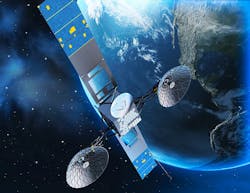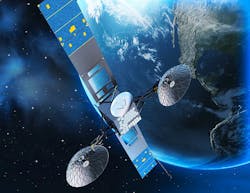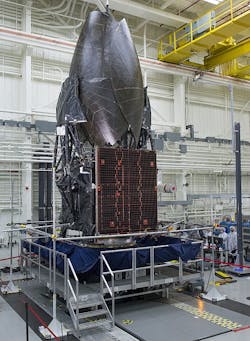ULA launches Boeing-built TDRS-M satellite to complete NASA space communications network
CAPE CANAVERAL, Fla. NASA’s Tracking and Data Relay Satellite (TDRS-M), part of a series of next-generation communications satellites, has been placed into orbit following separation from a United Launch Alliance (ULA) Atlas V rocket from Space Launch Complex 41 at Cape Canaveral Air Force Station, Florida. The TDRS-M launch was twice put in jeapardy: first due to a damaged antenna, and then from a thermal issue that caused a delay.
Ground controllers report the satellite is in good health at the start of a four-month checkout in space by its manufacturer, Boeing. NASA will conduct additional tests before putting TDRS-M into service early next year. When ready, TDRS-M will become part of NASA’s Space Network providing navigation and high-data-rate communications to the International Space Station, NASA’s Hubble Space Telescope, rockets, and a host of other spacecraft.
“The TDRS fleet is a critical connection delivering science and human spaceflight data to those who can use it here on Earth,” says Dave Littmann, the TDRS project manager at NASA’s Goddard Space Flight Center in Greenbelt, Maryland. “TDRS-M will expand the capabilities and extend the lifespan of the Space Network, allowing us to continue receiving and transmitting mission data well into the next decade.”
This sixth and final Boeing Tracking and Data Relay Satellite (TDRS) will enhance NASA’s space communications network when the satellite becomes fully operational early next year.
TDRS-M is the latest satellite in NASA’s TDRS constellation and will provide high-bandwidth communications to spacecraft in low-Earth orbit. The TDRS network enables continuous communication with the International Space Station, the Hubble Space Telescope, the Earth Observing System, and other programs supporting human space flight.
This is the sixth TDRS satellite Boeing has built for NASA, the first of which was delivered in 2000. After reaching its final orbit, the satellite will undergo testing and checkout before being declared operational.
“This TDRS-M milestone is another step forward in Boeing’s commitment to developing technologies to support future NASA near-Earth, moon, Mars and deep space missions – and to do so affordably, drawing on our 40-plus years of strong Boeing-NASA partnership,” says Enrico Attanasio, executive director, Department of Defense and civil programs, Boeing Satellite Systems.
The mission of the TDRS project, established in 1973, is to develop, launch, and deliver data communications relay spacecraft to support NASA's Space Network, which provides high-data-rate communications and accurate navigation. The TDRS-M spacecraft is effectively identical -- in both function and performance -- to the TDRS-K and -L spacecraft launched in 2013 and 2014, respectively.
Boeing conducted spacecraft integration and testing earlier this year at its satellite factory in El Segundo, California. After testing and confirming the spacecraft was ready for shipment, launch processing began following TDRS-M’s arrival in Florida 23 June 2017.
Boeing has provided space communication services to NASA for more than four decades, and has been NASA’s sole provider of tracking and data relay satellites since 1995.
NASA's Space Communications and Navigation program (SCaN) is part of the Human Exploration and Operations Mission Directorate at the agency's headquarters in Washington, and is responsible for the Space Network. The TDRS project office at Goddard manages the TDRS development program. Management of the launch service for TDRS-M is the responsibility of NASA’s Launch Services Program based at the agency's Kennedy Space Center in Florida. ULA provided the Atlas V rocket launch service.
Search the Aerospace & Defense Buyer's Guide
The go-to resource for Intelligent Aerospace technology news & information:
Covering key topics
Across all market segments
Subscribe to the free Intelligent Inbox e-newsletter
Subscribe to receive all the latest aerospace technology news & information, delivered directly to your e-mail inbox twice a week (Tuesdays and Thursdays). Sign upfor your free subscription to the Intelligent Inbox e-newsletter at http://www.intelligent-aerospace.com/subscribe.html.
Connect on social media
Keep pace with aerospace innovation and opportunities via your favorite social media channels. Connect with Intelligent Aerospace on Twitter (@IntelligentAero), LinkedIn,Google+, and Instagram.



